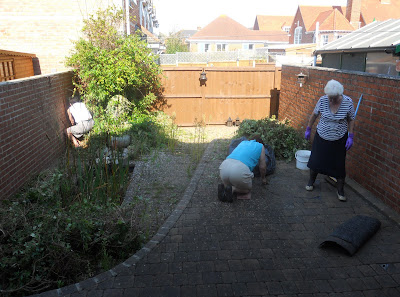As the final day of September arrives, how good it feels to be wandering around without a coat or jacket. Once again the sky was blue and full of sunshine with a light south easterly breeze but still little by way of 'visible' migration especially at the cemetery and Radipole.
 Portland also remained fairly quiet with Meadow Pipits, in far fewer number than of late predominated and the odd Blackcap, Wheatear for good measure. This Sparrowhawk did bring me back to life as it landed no more than a yard away from me, but didn't linger long enough for a shot.
Portland also remained fairly quiet with Meadow Pipits, in far fewer number than of late predominated and the odd Blackcap, Wheatear for good measure. This Sparrowhawk did bring me back to life as it landed no more than a yard away from me, but didn't linger long enough for a shot. Otherwise, it was more Raptors that brought the only avian interest as the resident juvenile Common Buzzard flew directly overhead,
Otherwise, it was more Raptors that brought the only avian interest as the resident juvenile Common Buzzard flew directly overhead, Next came 2 Peregrines in quick succession both looking to have prey and heading for the nest site further along the coast. Not unexpectedly a couple of Kestrel also put in an appearance followed by a
Next came 2 Peregrines in quick succession both looking to have prey and heading for the nest site further along the coast. Not unexpectedly a couple of Kestrel also put in an appearance followed by a Portland Oxpecker - it's a Carrion Crow really!
Portland Oxpecker - it's a Carrion Crow really!Real Oxpeckers
taken with a Box Brownie?
taken with a Box Brownie?
 Red-billed Oxpecker, Zambia 1997?
Red-billed Oxpecker, Zambia 1997? Yellow-billed Oxpecker, Botswana 1997?
Yellow-billed Oxpecker, Botswana 1997? With the recently refurbished St George's Church, Easton featuring on the local regional television news last night, it seemed appropriate to stop of and take a shot or two.
With the recently refurbished St George's Church, Easton featuring on the local regional television news last night, it seemed appropriate to stop of and take a shot or two. Built in the mid 1700's and designed on the plans of Sir Christopher Wren's Saint Paul's Cathedral, the architect must have misjudged the dome which is certainly lacking in size, but nonetheless doesn't detract from this magnificent monolith.
Built in the mid 1700's and designed on the plans of Sir Christopher Wren's Saint Paul's Cathedral, the architect must have misjudged the dome which is certainly lacking in size, but nonetheless doesn't detract from this magnificent monolith. Along with an abundance of interesting Tomb Stones
Along with an abundance of interesting Tomb Stones but also a monument
but also a monument to the World Renowned Stone Masons and Quarrymen who are historically synonymous with the Isle of Portland.
to the World Renowned Stone Masons and Quarrymen who are historically synonymous with the Isle of Portland.Garden by Groundhogs
from the 1970 album 'Thank Christ For The Bomb' (Tony TS McPhee)
if you don't own this work - do yourself a favour!
from the 1970 album 'Thank Christ For The Bomb' (Tony TS McPhee)
if you don't own this work - do yourself a favour!
My garden is all overgrown and the weeds are creeping up on my home,
Grass has grown over two foot high and the trees are blocking out the sky.
French windows won't open any more from the moss that's grown outside my door,
Hundred birds are nesting in the trees, looks like a wild-life sanctuary.
But I'm not going to cut a single blade of grass, my garden will look just like the distant past,
Before the days of agricultural land, before the time when pebbles turned to sand.
When I leave this house I'm going to stay, I'm forsaking my comforts to live another way,
Get my clothes from heaps, my food from bins, water from ponds and have tramps for my friends.
Grass has grown over two foot high and the trees are blocking out the sky.
French windows won't open any more from the moss that's grown outside my door,
Hundred birds are nesting in the trees, looks like a wild-life sanctuary.
But I'm not going to cut a single blade of grass, my garden will look just like the distant past,
Before the days of agricultural land, before the time when pebbles turned to sand.
When I leave this house I'm going to stay, I'm forsaking my comforts to live another way,
Get my clothes from heaps, my food from bins, water from ponds and have tramps for my friends.























































